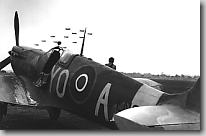The Battle of Britain

Having lost its principal ally, Britain with its Dominions stood alone and awaited a German invasion. Churchill, in eloquent speeches, rallied his people and expressed the determination of Britain to meet "the whole fury and might of the enemy." It was a formidable enemy. From the north cape of Norway to the Pyrenees stretched a vast arc of coastline from which enemy submarines, surface ships and aircraft threatened Britain's maritime lifelines; in the air the German Air Force outnumbered the British three to one. However, Hitler hesitated and delayed Operation Sea Lion—the invasion of Britain—to mid-September.
It was fortunate that an invasion did not come, for the forces in Britain were not yet prepared to meet such a powerful foe. While the troops had been rescued from Dunkirk, they had been compelled to leave behind most of their equipment. Further, many of them had not yet received adequate training. The 1st Canadian Division, which still possessed the bulk of its equipment, therefore assumed a position of vital importance. In July the Canadians became part of the 7th British Army Corps. This new formation, comprising British, Canadian and New Zealand troops, came under the command of General McNaughton. It engaged in intense preparation for a role of counter-attack against the expected German assault.
However, before a Channel crossing could be attempted, the Royal Air Force would have to be knocked from the skies. On August 12, 1940 the German Air Force, the Luftwaffe, struck at Britain attacking the radar stations, bombing the airfields, and engaging British fighters in an attempt to gain air supremacy. Had the policy been continued the Luftwaffe might have been victorious, but the Germans switched to mass daylight raids on London giving the Fighter Command the needed respite, and they were able to inflict staggering losses on the Luftwaffe. Unable to control the air, Hitler indefinitely postponed Operation Sea Lion. The Battle of Britain was over.
Many Canadians served in the squadrons of Spitfires and Hurricanes which repulsed the Luftwaffe in the summer of 1940. No. 1 Fighter Squadron, RCAF, equipped with modern eight-gun fighters, became the first Royal Canadian Air Force (RCAF) unit to engage enemy planes in battle when it met a formation of German bombers over southern England on August 26, 1940. It shot down three of them and damaged four others with the loss of one pilot and one plane. Its next meeting with the enemy was not as fortunate as it was attacked out of the sun by Messerschmitts and lost three planes. By mid-October the squadron had accounted for 31 enemy aircraft destroyed and probably 43 more destroyed or damaged. It lost 16 Hurricanes; thre pilots had been killed.
The Canadians flew with the Royal Air Force during that difficult period. No. 242 (Canadian) Squadron RAF, which had been formed in 1939 from some of the many Canadians who flew directly with the Royal Air Force, was now reinforced with Veterans from the French campaign and joined in the battle. On August 30, nine of its planes met a hundred enemy aircraft over Essex. Attacking from above, the squadron claimed 12 victories and escaped unscathed.
Canadians also shared in repulsing the Luftwaffe's last major daylight attack. On September 27, 303 Squadron RAF and 1 Squadron RCAF attacked the first wave of enemy bombers. Seven, possibly eight enemy planes were destroyed, and another seven damaged. The Royal Canadian Air Force thus received its baptism of fire.
Their invasion plans wrecked, the Germans turned to night bombing to destroy Britain's will to fight. For nine months, the British people suffered an aerial bombardment of their major cities that was then without precedent. It only strengthened the determination of the people. The attacks became less frequent. Great Britain survived the blitz.
- Date modified: